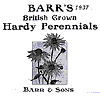accepted name (2005):
-
1890
Lynch's Original description
Sub-genus Paeon.
Herbaceous. Petals not leathery, large and expanding, much exceeding the sepals.
E. Leaves glaucous, or of very pale green above, generally of striking grey-green aspect; leaflets glaucous below, and very rarely without distinct pubescence, always divided, and with the lobes often fissured.
I. Flowers distinctly stalked, not apparently sessile, and resting on the upper leaves.
** Carpels hairy.
++ Terminal free divisions of the leaf three-lobed; the middle lobe rarely bifid, never trifid,
§ Leaflets about twice as long as broad.
21. P. Bakeri, n. sp. (P. peregrina byzantina, Hort. Barr).—
Root cylindrical or somewhat spindle-shaped. Stem stout, about 2 feet high, red or reddish, flexuose, pilose from the lowest leaf to the flower. Leaves about six, biternate, the lowest often inserted at nearly its own length from the ground, not quite one-third as long as the stem; petioles reddish; leaflets (all divisions cut to the midrib or secondary petiole, and in symmetry with the rest of the leaf), 13 to 15 of lower leaves, 3 to 3 1/2 inches long, broadly ovate, acute, margin reddish, and upper surface often suffused with reddish tint, all strongly decurrent and quite entire, except that the terminal middle leaflet may be cut once deeply (as in fig. 32), very hairy beneath and glaucous. Flowers always (apparently) 2-bracteate; calyx slightly hairy, sepals five, oval or rotundate; corolla deep rose, about 41/2 inches across, opening fairly flat; petals eight, obovate, slightly crisped, usually with white median line beneath. Carpels tending to three, arcuate.
One of the most distinct as a species in this group. Its habit resembles that of P. triternata. It is twice as tall as P. arietina Andersoni in the Cambridge Botanic Garden. Differs in important particulars from Anderson's description of peregrina byzantina, who does not remark some features of this plant. In the Kew Herbarium it is referred to pubens, but from that it differs greatly in the shorter leaflets and colour of the flower.
listed by:
1946
Stern' description
29. P.Bakeri Lynch in Journ. Roy. Hart. Soc. London, 12, 441, fig. 32 (1890) ; F. C. Stem, ibid. 56, 73 (1931) ; and 68, 127 (1943).
Description. Stem villous, about 60 cm. high. Lower leaves bitemate, with the terminal of each set of three usually trifurcate ; leaflets oval or ovate, mostly 7-10.5 cm. long and 3,5-6 cm. wide, broadly cuneate to almost truncate at the base, apex acute, dark green and glabrous above, glaucous and villous below ; petiole and petiolules villous, densely so at the base of the petiole. Flower about 11.5 cm. in diameter. Petals obovate to sub-orbicular, cuneate at the base, magenta-red. Stamens 1-5 cm. long, filaments red, anthers yellow. Carpels 3, densely tomentose.
Distribution. Known only from gardens. Herbarium specimens at Kew : Hort. H. J. Elwes, 31/7/1918 (K) ; F. C. Stern, 13/5/1931. 16/6/1931, -/5/I938, 10/5/1938 (K).
P.Bakeri is a mysterious plant which was described by Lynch (1890) from a plant growing in the Cambridge Botanic Gardens. It is no longer present in the Cambridge garden, but the other specimens in cultivation are known to be derived from that source. No specimen was kept and there is no known herbarium specimen of a corresponding wild plant. It has only been found P.bakeri true when come true in gardens.
It resembles P.arietina in that the stem, the back of the leaves and the carpels are hairy. The terminal leaflets also are usually divided to the base into two or three segments, and again, like P.arietina, it is a tetraploid. But the segments of the leaves are shorter making them broadly oval or ovate in outline, and it is a taller and more robust plant than P.arietina.
Like P.arietina it differs from P.mascula in possessing a greater number of leaflets of a different shape. It may be only a robust variety of P.arietina from some particular district yet to be discovered, or again it may be a form that has appeared in a garden and comes raised from seed.
This paeony has been grown at Highdown, where it seeds freely and the seedlings to type. It is a beautiful garden plant and easy to cultivate.
2002
in Wädenswil:






